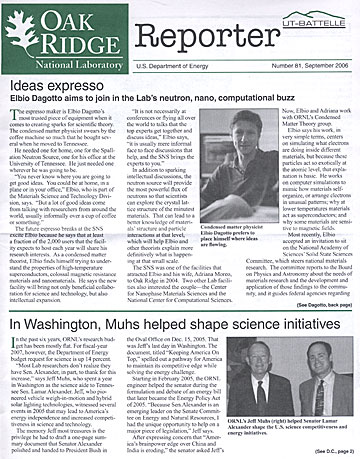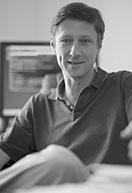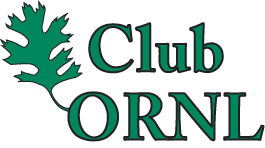 |
Number 81, September 2006 |
 Ideas expresso
Ideas expresso
Elbio Dagotto aims to join in the Lab’s neutron, nano, computational buzz
|
|
| Condensed matter physicist Elbio Dagotto prefers to place himself where ideas are flowing. |
The espresso maker is Elbio Dagotto’s most trusted piece of equipment when it comes to creating sparks for scientific theory. The condensed matter physicist swears by the coffee machine so much that he bought several when he moved to Tennessee.
He needed one for home, one for the Spallation Neutron Source, one for his office at the University of Tennessee. He just needed one wherever he was going to be.
“You never know where you are going to get good ideas. You could be at home, in a plane or in your office,” Elbio, who is part of the Materials Science and Technology Division, says. “But a lot of good ideas come from talking with researchers from around the world, usually informally over a cup of coffee or something.”
The future espresso breaks at the SNS excite Elbio because he says that at least a fraction of the 2,000 users that the facility expects to host each year will share his research interests. As a condensed matter theorist, Elbio finds himself trying to understand the properties of high-temperature superconductors, colossal magnetic resistance materials and nanomaterials. He says the new facility will bring not only beneficial collaboration for science and technology, but also intellectual expansion.
“It is not necessarily at conferences or flying all over the world to talks that the top experts get together and discuss ideas,” Elbio says, “it is usually mere informal face to face discussions that help, and the SNS brings the experts to you.”
In addition to sparking intellectual discussions, the neutron source will provide the most powerful flux of neutrons so that scientists can explore the crystal lattice structure of the minutest materials. That can lead to a better knowledge of materials’ structure and particle interactions at that level, which will help Elbio and other theorists explain more definitively what is happening at that small scale.
The SNS was one of the facilities that attracted Elbio and his wife, Adriana Moreo, to Oak Ridge in 2004. Two other Lab facilities also interested the couple—the Center for Nanophase Materials Sciences and the National Center for Computational Sciences. Now, Elbio and Adriana work with ORNL’s Condensed Matter Theory group.
Elbio says his work, in very simple terms, centers on simulating what electrons are doing inside different materials, but because these particles act so exotically at the atomic level, that explanation is basic. He works on computer simulations to mimic how materials self-organize, or arrange electrons in unusual patterns; why at lower temperatures materials act as superconductors; and why some materials are sensitive to magnetic fields.
Most recently, Elbio accepted an invitation to sit on the National Academy of Sciences’ Solid State Sciences Committee, which steers national materials research. The committee reports to the Board on Physics and Astronomy about the needs of materials research and the development and application of those findings to the community, and it guides federal agencies regarding their materials science research. Every few months Elbio will head to Washington, D.C., to exchange ideas and information about materials research with other solid-state scientists, politicians and federal agency representatives.
Elbio’s home base, at least half his time, is here at the Lab, though, and he has asked for an office that sits at the corner of the SNS and Nanophase Center. Putting himself at that juncture, the physicist will be able to mesh the data that scientists in each facility produce and develop his theories about nanointeractions.
“You cannot sit down and invest a certain amount of hours and then magically make a theory,” he says. “Sometimes I will sit in my office and just think; put things together in my mind.”
Often things do not work, the condensed-matter physicist says, but every now and then he gets a few sparks that lead to a good idea of how a given phenomenon works. Having those sparks leads to the next challenge: “You must prove it,” he says.
Working with experimentalists, Elbio can gain an idea of what the tests are showing to happen as electrons move or do not move in a particular material. That gives him a better idea of how to explain those movements and their relationship to the materials’ characteristics. Transition metal oxides are one example. Elbio wants to know why, at room temperature, these compounds often resemble ceramic bricks, but when cooled, they transform into superconductors.
Elbio says, however, it is impossible to study all the atoms in a particular material and develop a macroscopic theory of why that material acts as a superconductor.
“You can never simulate an entire material. You must break it down to a few hundreds of atoms and hope you still have the properties of the materials.”
Working at that small scale pushes Elbio’s studies into the realm of nanoscience. The physicist’s ability to develop a theory and simulation of the particle interactions at that level can help nanospecialists overcome the challenge in establishing how materials should behave.
“You cannot sit down and invest a certain amount of hours and then magically make a theory.” |
|---|
Scientists cannot use Newtonian physics when analyzing a few hundred atoms, however. Elbio says they must use quantum mechanics, where electrons—infinitely small points, in Elbio’s words—act like waves, not particles. Nanoscientists want to understand how that wave motion affects the material and how it acts.
“If we can understand how something like a high-temperature superconductor works on the small-scale level, it can lead to applications where we can raise the temperature to room temperature,” Elbio says. “So you could have wires that transmit current but don’t heat up.”
That is the big picture. Mainly the fundamentals intrigue Elbio. He also wants to know why these natural phenomena happen, a curiosity he has had since he was a child, he says.
“Science was very natural for me, and I was interested in nature from a young age.”
While he was in school, scientists were making major developments in quantum mechanics and astrophysics, fields entertaining the most challenging questions about nature, he says, which enticed Elbio to study physics, specifically high-energy physics.
After getting his doctoral degree at the Balseiro Institute in Argentina, the South American equivalent of MIT, Elbio moved to the University of Illinois to complete his postdoctoral work. It was not until he accepted an associate research position at the Institute for Theoretical Physics in California that the physicists flipped, in his words, to condensed-matter physics. That was about the time that high-temperature superconducting burst onto the scientific scene.
“Materials science influenced the whole world. It was more down to Earth,” he says. “Condensed matter can be exotic, but you are working with real materials that you can study in the lab.”
Jointly appointed at Oak Ridge and the University of Tennessee, Elbio has access to many labs and scientists to satisfy his intellectual curiosity, as he attempts to understand the nature of materials. And, of course, he has his espresso makers too.—Ashley Yeager ![]()
 In Washington, Muhs helped shape science initiatives
In Washington, Muhs helped shape science initiatives
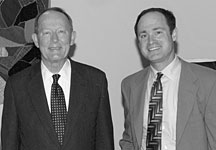 |
ORNL’s Jeff Muhs (right) helped Senator Lamar Alexander shape the U.S. science competitiveness and energy initiatives. |
In the past six years, ORNL’s research budget has been mostly flat. For fiscal-year 2007, however, the Department of Energy budget request for science is up 14 percent.
“Most Lab researchers don’t realize they have Sen. Alexander, in part, to thank for this increase,” says Jeff Muhs, who spent a year in Washington as the science aide to Tennessee Sen. Lamar Alexander. Jeff, who pioneered vehicle weigh-in-motion and hybrid solar lighting technologies, witnessed several events in 2005 that may lead to America’s energy independence and increased competitiveness in science and technology.
The memory Jeff most treasures is the privilege he had to draft a one-page summary document that Senator Alexander polished and handed to President Bush in the Oval Office on Dec. 15, 2005. That was Jeff’s last day in Washington. The document, titled “Keeping America On Top,” spelled out a pathway for America to maintain its competitive edge while solving the energy challenge.
Starting in February 2005, the ORNL engineer helped the senator during the formulation and debate of an energy bill that later became the Energy Policy Act of 2005. “Because Sen.Alexander is an emerging leader on the Senate Committee on Energy and Natural Resources, I had the unique opportunity to help on a major piece of legislation,” Jeff says.
After expressing concern that “America’s brainpower edge over China and India is eroding,” the senator asked Jeff’s help in developing a competitiveness agenda. Jeff’s job was to find experts on the subject and invite them to meet with the senator.
On May 11, the senator, with Jeff’s notes in hand, delivered an invited talk on competitiveness to the National Academies (National Academy of Sciences, National Academy of Engineering and the Institute of Medicine). There he posed the question, “What are the top 10 things we can do for America to keep its competitive edge in science and technology?” The upshot was that the Academies asked Sen. Alexander to write a formal letter commissioning the Academies to prepare a report that addressed his question. After receiving a bipartisan letter co-signed by Senators Alexander and Jeff Bingaman, the Academies appointed a 20-person committee chaired by Norman Augustine, retired chairman of Lockheed Martin.
Jeff challenged the Academies to seek fresh ideas from young researchers and teachers. One researcher selected was ORNL’s Craig Blue, who attended an all-day brainstorming session at the Academies in August 2005.
On October 5, Augustine briefed Sen. Alexander on the report, titled “Rising above the Gathering Storm: Energizing and Employing America for a Brighter Economic Future.” The report called for increased funding for basic research.
“To get more American students excited about studying science and technology, the report recommended mobilizing our vast scientific resources to solve America’s energy challenge,” Jeff says. “Just as Americans rallied around President Kennedy’s goal of sending a man to the moon during the Cold War, the challenge today—as America competes with China and India in an emerging jobs war—is to motivate ingenious Americans to develop a clean, reliable and affordable energy supply.”
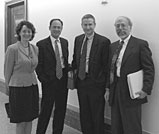 |
Halls of power: Jeff Muhs (second from left) is flanked by fellow Senate staffers Kathryn Clay (Sen. Domenici), Jonathan Epstein (Sen. Bingaman) and Jerry Hinkle (Sen. Dorgan) outside the Senate Energy Committee hearing room after the Oct. 17th hearing that helped launch the President’s American Competitiveness and Advanced Energy initiatives. |
The senator made the Academies’ report the subject of an October 17 hearing before the Energy and Natural Resources committee chaired by Senator Pete Domenici. Sen. Alexander called for the report’s recommendations to be a central focus of the President’s State of the Union address and domestic agenda.
The former governor, university president and cabinet-level secretary elevated the report further by handing it to Vice President Cheney on Air Force II and spearheading “homework” sessions attended by other senators, science policy makers and advisors at the Administration’s highest levels, as well as outside experts like former ORNL Director Bill Madia.
On December 15, Senators Alexander, Domenici and Bingaman met with President Bush in the White House to push the competitiveness and energy agendas. They handed the president the Academies’ report summarized by Jeff.
In his State of the Union address on January 31, 2006, the president announced the American Competitiveness Initiative and the Advanced Energy Initiative for reducing U.S. addiction to foreign oil. To show appreciation for Sen. Alexander’s hard work in developing the two initiatives, the president touted them in Nashville the next day.
“I was invited to Nashville to hear the president promote the two initiatives I worked on,” Jeff recalls with excitement, adding he knew whom to thank.—Carolyn Krause ![]()
 ORNL People
ORNL People
The Materials S&T Division’s Ted Besmann has been appointed a science advisor to the U.S.-Israel Bi-national Science Foundation. The foundation was established in 1972 by the governments of the United States and Israel to promote and support cooperative scientific and technological research for peaceful purposes and for the benefit of both countries.
Bob Hawsey has been named director of ORNL’s Energy Efficiency and Renewable Energy programs. For the past several years Bob has managed the Lab’s Electric Transmission and Distribution program.
Jeremy Busby of the Materials S&T Division has received the American Nuclear Society’s 2006 Landis Young Member Engineering Achievement Award. Past ORNL winners include Tim Valentine, Yousry Azmy, Ted Besmann and Everett Bloom.
The Chemical Sciences Division’s Parans Paranthaman was invited to write an article on superconductor wires for the 2006 McGraw-Hill Yearbook of Science & Technology. The yearbook “...provides a broad overview of important recent developments in science, technology, and engineering, as selected by a distinguished board of consulting editors.”
The Nuclear & Radiological Protection Division’s Steve Sims has been elected a fellow of the Health Physics Society, one of only three ORNL staff members to receive the honor.
The Environmental Sciences Division’s Virginia Dale and the Engineering S&T Division’s Kathy Johnson were honored by the Knoxville YWCA’s Tribute to Women. Virginia won in the science and technology category; Kathy won in the administrative-clerical professional category.
Retired ORNL environmental toxicologist Faye Martin received the lifetime achievement award at this year’s Oak Ridge YWCA banquet.
Jim Blencoe, Chemical Sciences Division, and Creative Media’s Allison Gray received a merit award in the Society for Technical Communication, Pittsburgh Chapter’s, 2005-2006 Technical Art Competition. Jim also shared a best poster award at the 2006 Annual American Association of Petroleum Geologists Convention.
 |
 Imaging project monitors the grid
Imaging project monitors the grid
ORNL’s role in the Hurricane Katrina recovery was documented in Reporter last fall (No. 72), describing the Geographic Information S&T group’s work for DOE’s Office of Electrity Delivery and Energy Reliability in assessing the storm season’s impact on populations, railways and ports.
The Lab’s role has continued and grown. A program that originated as a Lab-Directed R&D project to visualize, in real time, the health of the electricity grid was recently cited by Energy Secretary Samuel Bodman as one of the ways DOE has enhanced its preparedness for the 2006 storm season.
The project is a collaboration between the Computational Sciences & Engineering Division, the Engineering S&T Division and the Tennessee Valley Authority, which is a major player in the national power grid.
“The LDRD was to do wide-area visualization and state estimation of the electric grid,” explains CSED’s Arjun Shankar. “The project got momentum after the 2003 blackout. What became clear was if there is a wider-area awareness of what’s happening in the grid, individual operators can react better and get a predictive sense of what’s happening.
“We’re helping DOE get visualization info of grid status on their displays for situational awareness—live information—of the electric grid,” he says.
“The first thrust of the OEDER program was to do hurricane-time visualization before, during and after a storm to give responders a sense of what is happening with the grid. DOE is an important source of information.The visualizations would help support the response to problems,” Arjun says.
Arjun says the work shows the often maligned U.S. power grid actually does its job pretty well.
“The grid works so well that we take it for granted,” he says.—B.C.
 Standard language for threat detection
Standard language for threat detection
Sensors can detect threats like nuclear or biological weapons, but there is no standardized system that allows them to communicate with authorities and each other. Part of ORNL’s SensorNet program is to make that network possible.
“Our goal is to do for sensors what the Internet did for computers,” Bryan Gorman of the Computational Sciences and Engineering Division says.
The first step in establishing a sensor network is to agree upon technical standards. However, Bryan and others observed a lack of clarity within industry about which standards to adopt.
Together with the National Institute of Standards and Technology and Department of Defense, ORNL hosted a conference August 2-3 to harmonize the fundamental standards.
“We wanted to bring in people with a common interest in sensor networks but from different groups to help them understand where the state of the art is,” he says. “Hopefully it will lead to cooperative and collaborative efforts.”
Bryan wants that collaboration to lead to a dynamic framework that will define how sensors communicate and give sensor developers guidelines for how to develop sensors that work with the network.
He says lessons learned about networking and standards implementation from the Internet’s development process should allow the sensor community to get to a global sensor network sooner.
Commercial vendors have readily adopted standards at SensorNet test-beds in places like Fort Bragg, demonstrating that standards adoption is commercially viable.
Now all that Bryan and his colleagues need to do is convince the rest of the world to agree on those standards. —C.S.
 Sequencers target plant maladies
Sequencers target plant maladies
ORNL researchers have joined the fight against two plant pathogens, soybean root rot disease and sudden oak death. The plant maladies are as potentially bad as they sound—one threatens a vital food crop, the other has the potential to devastate eastern woodlands.
Both diseases are of the Phytophthora, or “plant destroyer,” species, a fungus-like group responsible for, among other catastrophes, the nineteenth-century Irish Potato Famine.
The Chemical Sciences Division’s Hayes McDonald and Alon Savidor, a doctoral candidate with the University of Tennessee-ORNL Genome Science and Technology Program and assigned to the Life Sciences Division, were among a number of authors of a recent paper, published in Science, that describes sequencing the genomes of Phytophthora sojae and Phytophthora ramorum, the soybean and oak diseases, respectively. UT, ORNL and a number of universities and labs worked with DOE’s Joint Genome Institute and the Virginia Bioinformatics Institute on the four-year project.
Crop losses to P. sojae already exceed $1 billion annually. Although the oak disease has been confined to the west coast,
P. ramorum has been detected in nurseries in the east, and foresters are worried about yet another woodland blight. Researchers hope the genome sequencing will provide clues on how to combat the pathogens.—B.C.
 It pays to teach in East Tennessee
It pays to teach in East Tennessee
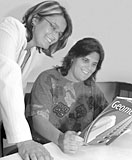 |
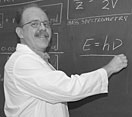 |
(From left) Jennifer Wilson, Barbara Roark and Rocky Warren are filling science and math teaching positions this fall. |
|
Students in Union and Morgan counties have new math and science teachers this fall, in some instances where they had none, thanks in part to a UT-Battelle effort to draw teachers to the rural school systems. The ORNL contractor offered a $10,000 “signing bonus” in return for a three-year commitment to teach school in the communities.
As a result, three teachers have signed on, two in Union County and one in Morgan County. Barbara Roark is teaching math at Union County High School.
“This is a great recruiting tool for schools and a terrific career incentive for the teachers,” says Roark, who will teach math under the program at Union County High School. “This program is one of the main reasons I’m here.”
Jennifer Wilson also arrived in Union County for her first teaching job. Rocky Warren, who did postdoctoral work at ORNL, will teach chemistry, physics and biology in Morgan County.
UT-Battelle, which has also invested approximately $350,000 in equipping school science labs in the region, says it is prepared to offer five signing bonuses a year and hopes the idea catches on with other companies.
—Reported by Bill Cabage and Charlie Smith |
 Marketable skill
Marketable skill
CCS intern’s ambition uncovers another application for EVEREST lab’s capabilities
Nekkion Crowder came to Oak Ridge National Laboratory’s Computer Sciences Division as an intern, set to write code that would detect bugs in visualization software that runs on the EVEREST theater.
One week after her arrival, the rising Fisk University computer science major—interning through ORNL’s Research Alliance in Math and Science program—realized she wasn’t having much fun.
“I just felt like I was doing what I was doing in the classroom,” Nekkion says she told her mentor, Sean Ahern, with ORNL’s Center for Computational Sciences. “He asked me what my passion was and what I would like to do.”
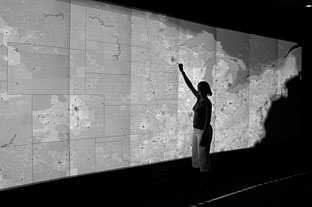 |
Center for Computational Sciences intern Nekkion Crowder plots market research data using ORNL’s EVEREST visualization laboratory. |
The result was a project that for the first time used computer visualization to map out market research—a potential tool for the Laboratory’s technology transfer program and other business-oriented applications.
With a double major in computer science and psychology, the Milwaukee native’s dream is to open youth centers that would target young men and women—ages 12 to 21—with an emphasis on technology as well as traditional education and recreational programs.
Sean tapped Pat Richardson, who oversees marketing research in ORNL’s Technology Transfer and Economic Development Division, to see if there was a way to explore Nekkion’s idea using his business expertise.
Pat was enthusiastic, proposing that Nekkion could do market research on her concept, pinpointing the locations of current centers and using geographic information system data to map out the best prospective sites.
“We basically struck gold,” Sean says. “Then the challenge was one of, how do we keep this rooted in computer science using EVEREST?”
Nekkion accomplished this by tying the data she uncovered into visualization software that allowed her to display the information on EVEREST, mapping out the location of current centers and, county-by-county, the density of child populations across the country. Part of the project included identifying the longitude and latitude for each center that fit the category Nekkion had established and creating a database that could be displayed on the 30-foot by 8-foot projector wall. In addition, Nekkion waded through many categories of demographic data to determine the best way to visualize the most promising sites.
“I wanted to see where things were visually, because I’m a visual learner,” she says, adding that her experience with EVEREST has given her tools to help future youth center participants learn through the visualization techniques she’s been practicing. Most important, Nekkion says Pat’s enthusiasm for the project gave her confidence to pursue her goal.
“When I first came I was very very confused about what I wanted to do,” she said. “Now I’m really excited about the youth centers. Pat made me believe I could do it.”
“What a thrill to see Nekkion’s marketing data displayed on EVEREST for the first time,” Pat says. “It’s been really fun to work with her over the summer and watch her grow.”
Sean says Nekkion’s internship didn’t produce the intended results, but that the project proved valuable in exploring and demonstrating yet another use for EVEREST.
“I could have stuck to my guns and said, ‘You’re going to do the project I assigned,’” he says. “But I don’t want people going away from Oak Ridge saying, ‘What a terrible place to work.’ An internship ought to be beneficial to both sides.”—Larisa Brass ![]()
 Interns pay tribute to their mentors
Interns pay tribute to their mentors
Researchers who spent time with this summer’s interns were honored on August 29 in a ceremony sponsored by the Oak Ridge Institute for Science and Education, which administers most of the Lab’s internships.
Following are excerpts of some of the testimonials from the students about their mentors.
“Through the time I’ve spent with him and advice given by him, I now know that I can truly do anything I set my mind to.” Mentor: Auroop Ganguly, Computational Sciences & Engineering Division
“At the end of every discussion, he would leave with a ‘Thanks,’ making me feel my time was valuable.” Mentor: George Fann, Computer Science & Mathematics Division
“When one of our experiments failed, I thought there was nothing to gain from the results. He helped me to realize that the data that we obtained were important.” Mentor: Joe Birdwell, Nuclear S&T Division
“After spending two years of doing nothing but studying ‘boring’ textbooks and taking tests, I had sort of lost a bit of desire to learn physics. My experiences working with my mentor have changed that.” Mentor: Steve Allison, Engineering S&T Division
“He threw me into the deep waters of scientific research and showed me how to swim!” Mentor: Michael Simpson, Materials S&T Division
“I was a guest in her house on several occasions for wonderful dinners where I was exposed to scientists from many different countries and cultures.” Mentor: Sara Pozzi, Nuclear S&T Division
“My mentor never treated me as if I was any less educated, continually valuing my input and respecting my opinions.” Mentor: Justin Baba, Engineering S&T Division
“He always made us feel a part of the “team” and never like interns.” Mark Bevelhimer, Environmental Sciences Division
“He gives me insights on graduate study schedules, fellowships and, most of all, ‘How not to go crazy while ‘limbo-ing’ your dissertation work!’” Derek Austin, Materials S&T Division
Other mentors honored were J.T. Simpson, T.J. Blasing, Joanna McFarlane, Mariappan Paranthaman, Bruce Pint, Kelly Roy, Ian Gross and Brad Weil. Outstanding educators honored included Debbie McCoy, Elias Greenbaum, Marty Schweitzer, Johney Boyd Green Jr. and Saylor Hummel, Edgar Lara-Curzio and Karen Simonson, Michael Smith, April McMillan, Nancy Gray and Lee Riedinger, as well as the Nuclear S&T Division’s educational program.—B.C. ![]()
 Cellulose-producing bacteria may
hold key to advanced bone repair treatments
Cellulose-producing bacteria may
hold key to advanced bone repair treatments
After biting into a piece of Nata de Coco, it is hard to imagine that bacteria, not humans, synthesize the bulk of this sweet treat. We can thank Gluconacetobacter, a nonpathogenic, cellulose-producing bacterium, for the popular Filipino dessert. And if dessert is not enough to bolster the little creature’s resumé, add to it the fact that the bacterium’s by-product has the potential to save our bones and our body.
Gluconacetobacter bacteria secrete a polysaccharide layer, called a pellicle, as their cloak of protection against ultraviolet radiation and drying. Requiring oxygen for survival, these aerobic bacteria primarily live at the surface of their liquid home, which consists of yeast, glucose, protein and water.
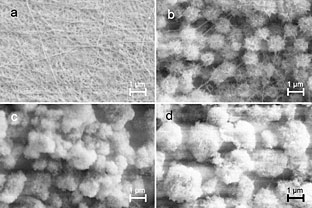 |
|
 |
Scanning electron microscope images of the bacterial cellulose and bacterial cellulose-bone mineral composites. The cellulose was infused with, from top left to lower right, zero, 53, 75 and 90 percent of the synthetic bone mineral respectively. The petri dish at left has samples of bacterial cellulose with and without the synthetic bone minerals. |
Each bacterium exudes a strand of cellulose that bonds to other strands, forming a ribbon that is about three nanometers thick, 70 nanometers wide and between one and nine micrometers long. Braiding and overlapping the ribbons, the bacteria then twist the cellulose into crystal lattice layers that lie on top of each other, giving depth to the pellicle.
“We just lift off that layer, clean it, and then we are ready to use it. It is similar to tissue,” Stacy Hutchens says.
Stacy, a University of Tennessee graduate student, began working with the bacteria four years ago. When she heard of an initial experiment showing that Nata de Coco cellulose cubes soaked in calcium and phosphate solutions formed a white mineral, Stacy was eager to start a research project in which she would synthesize a bone replacement material using a similar method. Citing ORNL chemical scientist Barbara Evans’ work as a starting point, Stacy ran with the idea of infusing the mineral found in bone into bacterial cellulose for her masters and now doctoral work.
She first learned how to culture Gluconacetobacter and its cellulose byproduct. Then the biomedical engineering student had to figure how to produce a bone-like structure to infuse into the bacterial gel. She became especially interested in bone replacement after a family member required the use of bone grafts to reinforce a jaw bone prior to dental implantation surgery.
Bone gel might be the answer to short supplies of cadaver tissue that surgeons use when treating severely damaged bone tissue or performing reconstructive surgery. |
|---|
Submerging the pellicle in calcium and then phosphate solutions, Stacy was able to form calcium-deficient hydroxyapatite, which is the main mineral component for bone and stimulates bone growth and regeneration when implanted, she says. Placing that compound in the cellulose allows the mineral composite to maintain its structure.
In the last two years, Stacy has analyzed the material properties of her bone gel with Dr. Roberto Benson in the Materials Science and Engineering Department at UTK, which she says has really kick-started her research.
Using scanning electron microscopy and
x-ray diffraction, Stacy found that the hydroxyapatite structures in her material were not that different from the hydroxyapatite in bone. Even the specific geometric symmetry found in real bone appeared in her calcium-phosphate-cellulose composite—strong evidence that her synthetic bone mimics living bone tissue.
“It really reminded me of bone itself,” she says.
Her findings appeared in Biomaterials in April. Stacy is preparing the required paper work to conduct a biological study in which she will implant her bone-like gel into an animal model. That test will determine whether the bone gel can attract developing bone cells, or osteoblasts, to an injured area and elicit bone regeneration. The calcium-deficient hydroxyapatite crystallizes into a layer that would allow real bone tissue to rapidly bond with it, Stacy says.
Since bone is the second most implanted tissue next to blood, Stacy’s bone gel might be the answer to the short supply of cadaver tissue that surgeons use when treating severely damaged bone tissue or performing reconstructive surgery. Hugh O’Neill, one of Stacy’s mentors at ORNL, says that the bone gel is ideal because it is clean and it is not immunogenic.
“There are a lot of safety issues with cadaver bone,” adds Barbara Evans, Stacy’s second advisor who works with Hugh in the Chemical Sciences Division. “There might be some disease or problem that the family was not aware of and that can be really dangerous for transplants.”
Stacy’s bone gel would solve the sanitary issues that complicate tissue transplants because cellulose is a pure hypoallergenic material. Stacy sterilizes the bone gel through autoclaving. Since the demand for human bone tissue is hard to supply, Stacy’s synthetic material would ease a surgeon’s need to find bone donors or subject patients to multiple operations.
There is still a lot to learn, Stacy says. Only time and testing will tell whether the cellulose produced by Gluconacetobacter will be as sweet an addition to bone tissue engineering as it has been as to the dessert market.—Ashley Yeager
Ashley Yeager and Charlie Smith were this summer’s interns from the University of Tennessee’s science writing program. ![]()
 How much do I need to retire?
How much do I need to retire?
Take time now to ensure that your retirement savings are enough
| By KATHRYN COGAR |
The question sounds simple and straightforward. And in fact, the basics are easier than you might think. Consider this: What’s the most expensive purchase you’ll ever make? It’s not your house or your kid’s college education. It’s your retirement! How much will your retirement cost?
An exercise in fifth grade math will give you a good ballpark estimate. Of course, inflation and your level of investment earnings ultimately need to be considered, but for now, let’s keep things simple: If suddenly tomorrow you were age 65 and it was your last day of work and things cost the same as they do today, how much would you want to spend each year? How close is that to what you spend today—is it the same, or more, or less? How many years do you think your retirement will last? If you’re going to live to age 85, that would be 20 years. Now simply multiply how much you’ll spend each year by the number of years and you have your personal retirement estimate.
Let’s say you dream of a lifestyle of $50,000 a year, retiring at age 65 and expecting to live to age 85. You’ll need 20 years of income x $50,000 = $1 million. That’s your retirement price tag. Is it what you expected or are you in sticker shock? Just like with buying a house, a car, a refrigerator or any other consumer item, there are things you can do now to buy the future that you want. In fact, you probably have some of that cost already covered.
The first step is to understand how much you already have toward meeting your retirement price tag and how much additional money you need to purchase your retirement dream. For most of us at ORNL, our retirement income will come from four sources:
• Pension
• Social Security
• 401(k) Savings Plan
• Personal Savings
To continue with our example, let’s calculate a pension based on $50,000 earnings and 20 years of service, using the regular formula—that’s $14,000/yr or $280,000 over 20 years.
Social Security comes to about $16,800/yr or $336,000 over 20 years. (Refer to Your 2006 Benefits Report or “Silver Bullet” for your own information or request a pension calculation from the OneCall Center, 574-1500).
That’s a good start toward meeting your retirement goal, but you’ll need an additional $384,000 from your 401(k) and/or personal savings (see the chart above).
Estimated retirement cost |
$1,000,000 |
|---|---|
Estimated payments Pension $14,000 x 20 years Social Security $16,800 x 20 years |
- 280,000 - 336,000 |
Estimated additional need |
$ 384,000 |
According to a recent study by the Employee Benefit Research Institute (EBRI) and the Investment Company Institute (ICI), the average 401(k) account balance at year end 2005 was $102,000. The ORNL average is around $160,000. Depending on which number you use, in our example, there is a gap of $282,000 or $224,000, substantial in either case.
Now the issues get a little more complicated. How much should you be contributing today to fill that gap and meet your goal? How should you be investing your contributions? The answers depend on how much you’ve already saved and how much time you have until you retire. Obviously, the longer your time horizon, the more time you have to save and to let your contributions grow. You can take advantage of the compounding effect where the money you invest earns interest which then earns more interest, and so on. By saving as soon as you can and as much as you can, you are much more likely to reach your goal.
Conventional wisdom says that as you get closer to retirement, your investments should become more conservative. After all, you don’t have as much time to recover from any losses in the market. But, you may live another 20 years in retirement. If you are currently 10 years from retirement, that’s a
30-year time horizon. You need to think about what level of risk is right for you to reach your goal and ensure that your income after your career ends will last as long as you live.
So how are we doing? Are ORNL employees getting the maximum value from the 401(k) to meet retirement goals? The latest report from CitiStreet, our 401(k) recordkeeper, is mixed. As of June 30, 2006, participation is 89.4 percent, well above the national average. Our average contribution rate is 8.76 percent although our plan allows for contributions as high as 60 percent (16 percent for highly compensated employees).
The company adds another 4 percent as a matching contribution to your first 6 percent. However, a little over 11 percent do not contribute enough and miss out on the full company match. UT-Battelle is currently contributing $11 million annually to employee accounts in matching contributions, but 367 of us are not taking full advantage of this free money.
Assets and account balances follow a predictable pattern based on our demographics, with the oldest age group holding the largest average balance. But the balances themselves may be of concern. Although our average balance is above the national trend, it is significantly below the amount needed in our example above. When broken down by age groups, even those in the age 60 and older group have balances below the amount needed. Do you have additional personal savings to fill the gap or do you need to save more?
Our investments also follow a trend toward taking less risk as we get older. We invest very heavily in our most conservative, short term or Stable Value fund. We have 12 different funds in our plan, yet over one-fourth of us invest in only one fund, predominately the Stable Value fund. Will such a conservative investment strategy earn the rate of return you need to meet your retirement goals?
As you can see, the answer to how much you need for retirement is as unique as each individual and his or her retirement dreams. Yet the basic questions are the same for all of us: How much do you need? Have you taken inflation and rising health care costs into account? How much do you have? Are you saving enough? Are you investing properly? Determining the answers is the first step toward achieving your retirement dreams.
 Benefits fair Oct. 12
Benefits fair Oct. 12
ORNL’s Benefits & Wellness Fair is set for Thursday, Oct. 12, from 10 a.m. to 3 p.m., in the Main Street and Conference Center areas with a theme of “Take Action! Live Well!” Exhibits will feature • Health Screenings & Education
• Benefits Providers
• Fitness & Nutrition
• University Programs
• Safety
• Financial Planning
• Work-life Balance
|
|
|---|---|
ORNL retirees can now see upcoming Club ORNL events and information on the Web. Go to http://www.ornl.gov/adm/clubornl_signup.shtml and follow the instructions to create an account. Once your account has been approved, you’ll be able to keep up with Club ORNL on-line. Nancy Gray (576-9479, graynl@ornl.gov) is the club’s point of contact for retirees. Lab employees can check out the club’s Website at home.ornl.gov/general/clubornl/. |
 New Staff
Members
New Staff
Members
Douglas Allen Bunch, Kevin Boyd Hamby, Jamie John Molaison, Ian Walter Evans, George Michael Herron, Wanda Elane Streets, Rocky Allen Armstrong, Candice Elizabeth Halbert and Timothy Paul Russell, SNS Experimental Facilities
Sydney Nail Murray III, Ekaterina Nikolayevna Danilova and Jeffrey Darrel Bryan, SNS Accelerator Systems
Warren Chappelle Edwards and Shirley Huling McKamey, National Security
Timothy Wayne Guilliams, Brandon Dale Henderson, William Blake Housley, Antoine Joubert Johnson, Chad Derek Loy, Debbie J. Robinson, Stephen Calvin Rose Jr. and Stephanie Michelle Layden, Craft Resources
Kathryn Parke Bugbee, Facilities Development
Marc E. Hampton, Nuclear Science & Technology
Troy Allen Jensen, Research Reactors
Richard Michael Lusk, Computational Sciences & Engineering
Robyn Jeanette Rose, US ITER Project
Suresh Kumar Santhana-Vannan, Environmental Sciences
George Alexander Barclay, Research Reactors
Victor Gene Hazlewood, Ofc. of Chief Information Officer
Kathy A. Huczko, Quality Systems & Services
Michael Alan McGuire, Materials Science & Technology
Edoardo Aprà, Computer Science & Mathematics
Beverly Gonzales, Engineering Sciences & Technology
Ava Yvonne Hamby, Business & Information Services
Lisa Roberts, Nuclear Technology Programs
Marion Donald Frederick, Feiyi Wang and John Clay England III, Center for Computational Sciences
Kevin Lee Shuford, Chemical Sciences
Sara Kathryn Hornbeck, Human Resources
Bill Cabage, editor, ORNL, 865/574-4399 (cabagewh@ornl.gov)
Deborah Barnes, associate editor, 865/576-0470 (barnesds@ornl.gov)
ORNL office: P.O. Box 2008, Oak Ridge, TN 37831-6146, Building 4500-N, Room K-238, MS 6266
News Deadlines
DOE inspector general hotline: 1-800-541-1625
[an error occurred while processing this directive] [an error occurred while processing this directive]
